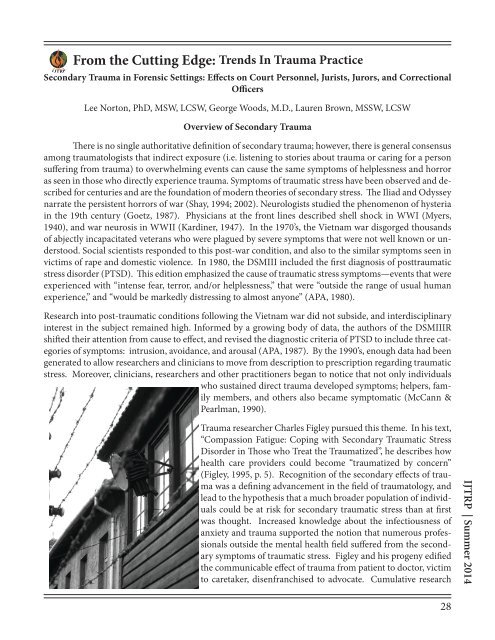International Journal of Trauma Research and Practice - Anger Study_0
International Journal of Trauma Research and Practice - Anger Study_0
International Journal of Trauma Research and Practice - Anger Study_0
Create successful ePaper yourself
Turn your PDF publications into a flip-book with our unique Google optimized e-Paper software.
From the Cutting Edge: Trends In <strong>Trauma</strong> <strong>Practice</strong>Secondary <strong>Trauma</strong> in Forensic Settings: Effects on Court Personnel, Jurists, Jurors, <strong>and</strong> CorrectionalOfficersLee Norton, PhD, MSW, LCSW, George Woods, M.D., Lauren Brown, MSSW, LCSWOverview <strong>of</strong> Secondary <strong>Trauma</strong>There is no single authoritative definition <strong>of</strong> secondary trauma; however, there is general consensusamong traumatologists that indirect exposure (i.e. listening to stories about trauma or caring for a personsuffering from trauma) to overwhelming events can cause the same symptoms <strong>of</strong> helplessness <strong>and</strong> horroras seen in those who directly experience trauma. Symptoms <strong>of</strong> traumatic stress have been observed <strong>and</strong> describedfor centuries <strong>and</strong> are the foundation <strong>of</strong> modern theories <strong>of</strong> secondary stress. The Iliad <strong>and</strong> Odysseynarrate the persistent horrors <strong>of</strong> war (Shay, 1994; 2002). Neurologists studied the phenomenon <strong>of</strong> hysteriain the 19th century (Goetz, 1987). Physicians at the front lines described shell shock in WWI (Myers,1940), <strong>and</strong> war neurosis in WWII (Kardiner, 1947). In the 1970’s, the Vietnam war disgorged thous<strong>and</strong>s<strong>of</strong> abjectly incapacitated veterans who were plagued by severe symptoms that were not well known or understood.Social scientists responded to this post-war condition, <strong>and</strong> also to the similar symptoms seen invictims <strong>of</strong> rape <strong>and</strong> domestic violence. In 1980, the DSMIII included the first diagnosis <strong>of</strong> posttraumaticstress disorder (PTSD). This edition emphasized the cause <strong>of</strong> traumatic stress symptoms—events that wereexperienced with “intense fear, terror, <strong>and</strong>/or helplessness,” that were “outside the range <strong>of</strong> usual humanexperience,” <strong>and</strong> “would be markedly distressing to almost anyone” (APA, 1980).<strong>Research</strong> into post-traumatic conditions following the Vietnam war did not subside, <strong>and</strong> interdisciplinaryinterest in the subject remained high. Informed by a growing body <strong>of</strong> data, the authors <strong>of</strong> the DSMIIIRshifted their attention from cause to effect, <strong>and</strong> revised the diagnostic criteria <strong>of</strong> PTSD to include three categories<strong>of</strong> symptoms: intrusion, avoidance, <strong>and</strong> arousal (APA, 1987). By the 1990’s, enough data had beengenerated to allow researchers <strong>and</strong> clinicians to move from description to prescription regarding traumaticstress. Moreover, clinicians, researchers <strong>and</strong> other practitioners began to notice that not only individualswho sustained direct trauma developed symptoms; helpers, familymembers, <strong>and</strong> others also became symptomatic (McCann &Pearlman, 1990).<strong>Trauma</strong> researcher Charles Figley pursued this theme. In his text,“Compassion Fatigue: Coping with Secondary <strong>Trauma</strong>tic StressDisorder in Those who Treat the <strong>Trauma</strong>tized”, he describes howhealth care providers could become “traumatized by concern”(Figley, 1995, p. 5). Recognition <strong>of</strong> the secondary effects <strong>of</strong> traumawas a defining advancement in the field <strong>of</strong> traumatology, <strong>and</strong>lead to the hypothesis that a much broader population <strong>of</strong> individualscould be at risk for secondary traumatic stress than at firstwas thought. Increased knowledge about the infectiousness <strong>of</strong>anxiety <strong>and</strong> trauma supported the notion that numerous pr<strong>of</strong>essionalsoutside the mental health field suffered from the secondarysymptoms <strong>of</strong> traumatic stress. Figley <strong>and</strong> his progeny edifiedthe communicable effect <strong>of</strong> trauma from patient to doctor, victimto caretaker, disenfranchised to advocate. Cumulative researchIJTRP | Summer 201428


